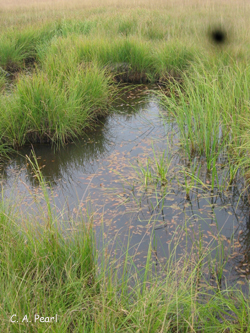The Oregon spotted frog (Rana pretiosa) is a Candidate Species for listing under the Endangered Species Act by US Fish and Wildlife Service. This highly aquatic species once ranged from British Columbia south to California, but now remains in less than 30% of its former range. It needs warm, shallow water for its eggs and larvae and uses deep-water pools and springs to overwinter. Factors that may be involved include habitat loss and degradation, drought, changes in hydrology, introduced species, isolation of populations, and possibly disease. The Oregon Wildlife Institute is embarking on both research and management activities for this species as well as conservation planning.
Jack Creek Site Management Plan
 In conjunction with the U.S. Forest Service, the Oregon Wildlife Institute developed a site management plan for this population of frogs within the Klamath Basin. The site is a mix of public and private ownership, and has been used for summer cattle grazing for the last century. The Oregon Wildlife Institute identified potential management actions to improve habitat and restore the site’s hydrology, and provided guidance for appropriate grazing strategies if cattle grazing continues to be conducted in the Jack Creek system.
In conjunction with the U.S. Forest Service, the Oregon Wildlife Institute developed a site management plan for this population of frogs within the Klamath Basin. The site is a mix of public and private ownership, and has been used for summer cattle grazing for the last century. The Oregon Wildlife Institute identified potential management actions to improve habitat and restore the site’s hydrology, and provided guidance for appropriate grazing strategies if cattle grazing continues to be conducted in the Jack Creek system.
Sponsor: Interagency Special Status/Sensitive Species Program (US Forest Service and Bureau of Land Management)